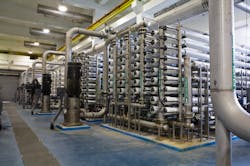An innovative, economical and efficient method of silica removal from waters
The removal of contaminants, such as silica, from water can be a challenging proposition. Some examples of industries that need to remove silica from the water before discharge or reuse are: cooling towers, boiler blow feed water or boiler blow down water, carwashes, semi-conductor manufacturers and steam injection oil recovery wastewater. Really, any industry that processes wastewater for discharge or reuse often faces the challenge of removing silica from their process water.
Silica in water most often is naturally-occurring. Some of it is man-made, such as carwash water. Silica, in general, is reactive silica and colloidal silica. Whatever form this constituent is in, silica must be removed before treatment and reuse or disposal/discharge. The most familiar methods for removing silica from a waste stream are lime softening, ion exchange and reverse osmosis.
Lime softening
Lime softening is one of the most common methods for removing silica from water such as make up to cooling towers, make up to boilers or boiler blow down water. Lime softening utilizes the addition of lime (calcium hydroxide) to remove hardness (calcium carbonate and magnesium carbonate) ions by precipitation. Silica particles are absorbed in flakes of magnesium and calcium hydroxides. These flakes (floc) can then be sent to a clarifier or filter where the separated silica can be disposed. As the percentage of silica in the water changes, so must the percentages of chemicals that must be added.
In many cases, heavy metals will be present in the sludge (settled floc) and will require the extra expense of disposal into a hazardous waste facility. Lime softening typically requires a fairly sizable capital investment and can be costly due to the quantity of chemicals used and disposal costs of large amounts of residuals produced, especially if hazardous waste facilities are needed.
Ion exchange
According to Wikipedia, ion exchange is, “An exchange of ions between two electrolytes or between an electrolyte solution and a complex. In most cases, the term is used to denote the processes of purification, separation and decontamination of aqueous and other ion-containing solutions with solid polymeric or mineralic ion exchangers.”
Ion exchange works very well for the removal of silica; however, the disadvantage of this process is that the resin exchangers need continual recharging and replacement, adding significant ongoing costs to the process. In addition, if there are heavy metals within the exchange resins with the silica, these concentrated ion metals usually do not pass the TCLP leachability test and must be disposed of in a hazardous classified landfill, adding further expense.
Reverse osmosis
Reverse osmosis (RO) is a membrane-technology filtration method that removes many types of large molecules and ions from solutions by applying pressure to the solution when it is on one side of a selective membrane. The result is that the solute is retained on the pressurized side of the membrane and the pure solvent is allowed to pass to the other side. To be “selective,” this membrane should not allow large molecules or ions through the pores (holes), but should allow smaller components of the solution, such as the solvent, to pass freely.
Using reverse osmosis or any membrane technology to remove silica can be problematic. Silica is like glass and will cut holes in the membrane and will decrease the efficacy of a membrane because of the abrasiveness of the particles. Heavy metals foul membranes, leading to failure. Membrane systems should have a pretreatment regimen to get rid of the constituents that foul membranes. If pretreatment is done prior to membrane treatment, then membranes will perform optimally without expensive replacement.
A simple, economical and efficient approach to silica removal
Electrocoagulation (EC) will successfully remove silica, heavy metals and other contaminants from aqueous solutions. With the use of clean electricity, electrocoagulation efficiently removes a wide range of contaminants with a single system. The EC makes constituents in the water “separable.” Heavy metals are converted from ion forms to oxide forms, allowing them to be disposed in a non-hazardous landfill.
Because electrocoagulation utilizes methods that precipitate out large quantities of contaminants in one operation, the technology is the distinct economical and environmental choice for industrial, commercial and municipal waste treatment. The capital and operating costs are usually significantly less than chemical coagulation.
The EC chamber consists of flat metal blades placed parallel to each other. Untreated water is introduced into the bottom of the chamber and is dispersed evenly as it moves upward through the blades. Direct current is applied to the first and last blade.
The liquid then becomes a conductor, allowing the current to pass freely throughout the chamber. This results in a flood of electrons into the water, neutralizing charged particles, causing them to precipitate out of solution. In addition, the metal blades react to the current by releasing charged metal ions that act similar to chemical coagulants. EC has become recognized as a very effective means for economically treating a wide variety of challenging water treatment applications and are available in sizes ranging from 1 gpm to multiples of 2,500 gpm.
In summary, electrocoagulation may soon move from the optional treatment method to the essential treatment method as the Environmental Protection Agency begins to enforce the laws protecting the environment from toxic wastes, including heavy metals. Electrocoagulation cleans most wastewater streams with less operating cost and produces less sludge than chemical precipitation. The metal oxides that remain in the sludge will pass leachability tests (TCLP), allowing the sludge to be disposed in a non-hazardous landfill. The reuse opportunities for the water are increased because dissolved solids are not added to the wastewater stream.
Judd E. Sundine is the president of Sundine Enterprises. Sundine has more than 39 years of experience in the horticulture, wastewater and environmental field. He specializes in natural wastewater remediation, bioremediation, erosion control, soil amendments, biological microalgae aeration and animal waste remediation. He has extensive knowledge of the turf field, specifically golf courses and sports turf.
